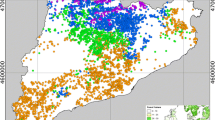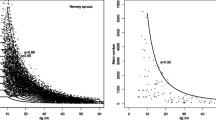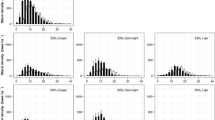Abstract
Self-thinning of forest stands is one of the clearest and best-documented examples of natural selection. Besides their theoretical interest, understanding of self-thinning is important for forest practice because it produces estimates of stand density and stocking. There is a considerable diversity of views on the processes causing self-thinning, predicting variables, and analytical form of models. The most popular model was proposed by Reineke (J Agric Res 46(7):627–638, 1933) over 70 years ago. This study compares existing models of self-thinning and provides evidence that the virtually unknown model developed by Artur Nilson describes self-thinning more realistically than Reineke’s. While in the Reineke model the rate of mortality (the slope of self-thinning line) is assumed to be constant, it changes from 0 to −2 in Nilson’s model. As a result, Nilson’s model is slightly but consistently more accurate than Reineke’s. Although both models are empirical, their analysis suggests several general conclusions about self-thinning.
Similar content being viewed by others
References
Alban DH, Laidly PR (1982) Generalized biomass equations for jack and red pine in the Lake States. Can J For Res 12:913–921
Averell JL (1945) Rules of thumb for thinning loblolly pines. J For 43(9):649–651
Avery TE, Burkhart HE (2002) Forest measurements, 5th edn. McGraw-Hill, New York, 456 pp
Bella IE (1971) A new competition model for individual trees. For Sci 17:364–372
Bonnor GM (1964) The influence of stand density on the correlation of stem diameter with crown width for lodgepole pine. For Chron 40(3):347–349
Briegleb PA (1952) An approach to density measurement in Douglas-fir. J For 50:529–536
Brown J (1882) The forester or a practical treatise on the planting, rearing, and general management of forest trees, 5th edn. Blackwood, Edinburgh, 898 pp
Chisman HH, Schumacher FX (1940) On the tree-area ratio and certain of its applications. J For 38(4):311–317
Curtis R (1970) Stand density measures: an interpretation. For Sci 16(4):403–414
Curtis RO (1971) A tree area power function and related stand density measures for Douglas-fir. For Sci 17(2):146–159
Czarnowski MS (1961) Dynamics of even-aged forest stands. Louisiana State University Press, Baton Rouge, 132 pp
Dawkins HC (1963) Crown diameters: their relation to bole diameter in tropical forest trees. Commonw For Rev 42:318–333
Enquist BJ (2002) Universal scaling in tree and vascular plant allometry: toward a general quantitative theory linking plant form and function from cells to ecosystems. Tree Physiol 22:1045–1064
FIA data http://srsfia2.fs.fed.us/. Accessed 12 Feb 2007
Francis JK (1986) The relationship of bole diameter and crown widths for seven bottomland hardwood species. USDA Forest Service Research Note SO-328, 3 pp
Gering LR, May DM (1995) The relationship of diameter at breast height and crown diameter for four species groups in Hardin county, Tennessee. South J Appl For 19(4):177–181
Gevorkiantz SR, Zon R (1930) Second-growth white pine in Wisconsin: its growth and yield, and commercial possibilities. Wis Agr Exp Sta Res Bull 98:40
Gingrich SF (1967) Measuring and evaluating stocking and stand density in upland hardwood forest in the central states. For Sci 13(1):38–53
Harding RB, Grigal DF (1985) Individual tree biomass estimation equations for plantation-grown white spruce in northern Minnesota. Can J For Res 15:738–739
Harms WR, Whitesell CD, DeBell DS (2000) Growth and development of loblolly pine in a spacing trial planted in Hawaii. For Ecol Manag 126:23–24
Huxley JS (1932) Problems of relative growth. The Dial Press, New York, 276 pp
Krajicek JE, Brinkman KA, Gingrich SF (1961) Crown competition—a measure of density. For Sci 7(1):35–42
Lambert M-C, Ung C-H, Haulier F (2005) Canadian national tree aboveground biomass equations. Can J For Res 35(8):1996–2018
Leech JW (1984) Estimating crown width from diameter at breast height for open-grown radiate pine trees in South Australia. Aust For Res 14:33–337
Lexen B (1939) Space requirement of ponderosa pine by tree diameter. USDA Forest Service Southwestern Forest and Range Experiment Station Research Note No. 63, 4 pp
Lohrey RE (1985) Aboveground biomass of planted and direct-seeded slash ine in the West Gulf Region. In: Saucier JR (ed) The 1984 Southern Forest Biomass Workshop. USDA Forest Service, Southeastern Forest Experiment Station, pp 75–82 (121 pp)
Long JN, Smith FW (1984) Relation between size and density in developing stands: a description and possible mechanisms. For Ecol Manag 7:191–206
MacKinney AL, Chaiken LE (1935) A method of determining density of loblolly pine stands. USDA Forest Service Appalachian Forest Experiment Station Technical Note No. 15, 3 pp
Mandelbrot BB (1983) The fractal geometry of nature. W. N. Freeman, New York, 468 pp
McIntosh RP (1980) The background and some current problems of theoretical ecology. Synthese 43:195–255
McQuarrie ADR, Tsai CL (1998) Regression and time series model selection. World Scientific, Singapore, 455 pp
Meyer WH (1938) Yield of even-aged stands of ponderosa pine. USDA Technical Bulletin 630, 59 pp
Meyer WH (1942) Yield of even-aged stands of loblolly pine in northern Louisiana. School of Forestry Bulletin 51. Yale University, New Haven, 39 pp
Mitchell HC (1943) Regulation of farm woodlands by rule of thumb. J For 41(4):243–248
Nilson A (1973) Hooldusraiete arvutusliku projekteerimise teooriast. [On the theory of programming of thinnings] Eesti Põllumajanduse Akadeemia tead. tööde kogumik. Tartu 89:136–142 [In Estonian]
Nilson A (2006) Modeling dependence between the number of trees and mean tree diameter of stands, stand density and stand sparsity. In: Cieszewski CJ, Strub M (eds) Proceedings of the 2nd international conference on forest measurements and quantitative methods and management & the 2004 southern mensurationists meeting. Warnell School of Forestry and Natural Resources, University of Georgia, Athens, pp 74–94 (412 pp)
Ouellet D (1985) Biomass equations for six commercial tree species in Quebec. For Chron 61:218–222
Paine DP, Hann DW (1982) Maximum crown-width equations for southwestern Oregon tree species. Forest Research Laboratory, Oregon State University, Corvallis. Research Paper. 46, 20 p
Painter PR (2005) The fractal geometry of nutrient exchange surfaces does not provide an explanation for 3/4-power metabolic scaling. Theor Biol Med Model 2:30. http://www.pubmedcentral.nih.gov/articlerender.fcgi?artid=1226149
Perez JW (1970) Relation of crown diameter to stem diameter in forests of Puerto Rico, Dominica, and Thailand. In: Odum HT, Pigeon RF (eds) A tropical rain forest; a study of irradiation and ecology at El Verde, Puerto Rico. U.S. Atomic Energy Commission, Oak Ridge, Tenn, pp B105–B122
Reineke LH (1933) Perfecting a stand-density index for even-aged forests. J Agric Res 46(7):627–638
Spurr SH (1952) Forest inventory. Ronald Press, New York, 476 p
Stahelin R (1949) Thinning even-aged loblolly and slash pine stands to specified densities. J For 47(7):538–540
Tarashkevitch A (1926) The composition of pure stands. Collection of works on forestry. Leningrad Agricultural Institute, pp 106–135 (In Russian)
Tjurin A (1927) The structure of even-aged stands. Memoirs of the Voronezh Institute of Agriculture 8:5–49 (In Russian)
USDA (1929) Volume, yield, and stand tables for second-growth southern pines. USDA Miscellaneous publication No. 50, 202 pp
Vezina PE (1962) Crown width-d.b.h. relations for open-grown balsam fir and white spruce in Quebec. For Chron 38:463–473
Vezina PE (1963) More about the crown competition factor. For Chron 39:313–317
Weller DE (1987) A reevaluation of the -3/2 power rule of self-thinning. Ecol Monogr 57(1):23–43
West GB, Brown JH, Enquist BJ (1997) A general model for the origin of allometric scaling laws in biology. Science 276:122–126
West GB, Brown JH, Enquist BJ (1999) A general model for the structure and allometry of plant vascular systems. Nature 400:664–667
Whittington R (1984) Laying down the -3/2 power law. Nature 311:217
Williams RA (1994) Stand density management diagram for loblolly pine plantations in north Louisiana. South J Appl For 18(1):40–45
Wilson FG (1946) Numerical expression of stocking in terms of height. J For 44:758–761
Yoda K, Kira T, Ogawa H, Hozumi K (1963) Self-thinning in overcrowded pure stands under cultivated and natural conditions. J Biol Osaka City Univ 14:107–129
Zeide B (1985) Tolerance and self-tolerance of trees. For Ecol Manag 13:149–166
Zeide B (1986) Crown width and stem diameter in open-grown trees. In: Fujimori T, Whitehead D (eds) Crown and canopy structure in relation to productivity. Forestry and Forest Products Research Institute, Ibaraki, pp 146–158, 448 p
Zeide B (1987) Analysis of the 3/2 power law of self-thinning. For Sci 33:517–537
Zeide B (1991) Self-thinning and stand density. For Sci 37:517–523
Zeide B (2005) How to measure stand density. Trees Struct Funct 19(1):1–14
Zeide B (2008) The science of forestry. J Sustain For 27(4):345–473
Zeide B, Pfeifer P (1991) A method for estimation of fractal dimension of tree crowns. For Sci 37:1253–1265
Acknowledgments
The author thanks Mike Olson, Curtis VanderSchaaf, and two anonymous referees for their valuable comments.
Author information
Authors and Affiliations
Corresponding author
Additional information
Communicated by T. Fourcaud.
Rights and permissions
About this article
Cite this article
Zeide, B. Comparison of self-thinning models: an exercise in reasoning. Trees 24, 1117–1126 (2010). https://doi.org/10.1007/s00468-010-0484-z
Received:
Revised:
Accepted:
Published:
Issue Date:
DOI: https://doi.org/10.1007/s00468-010-0484-z




